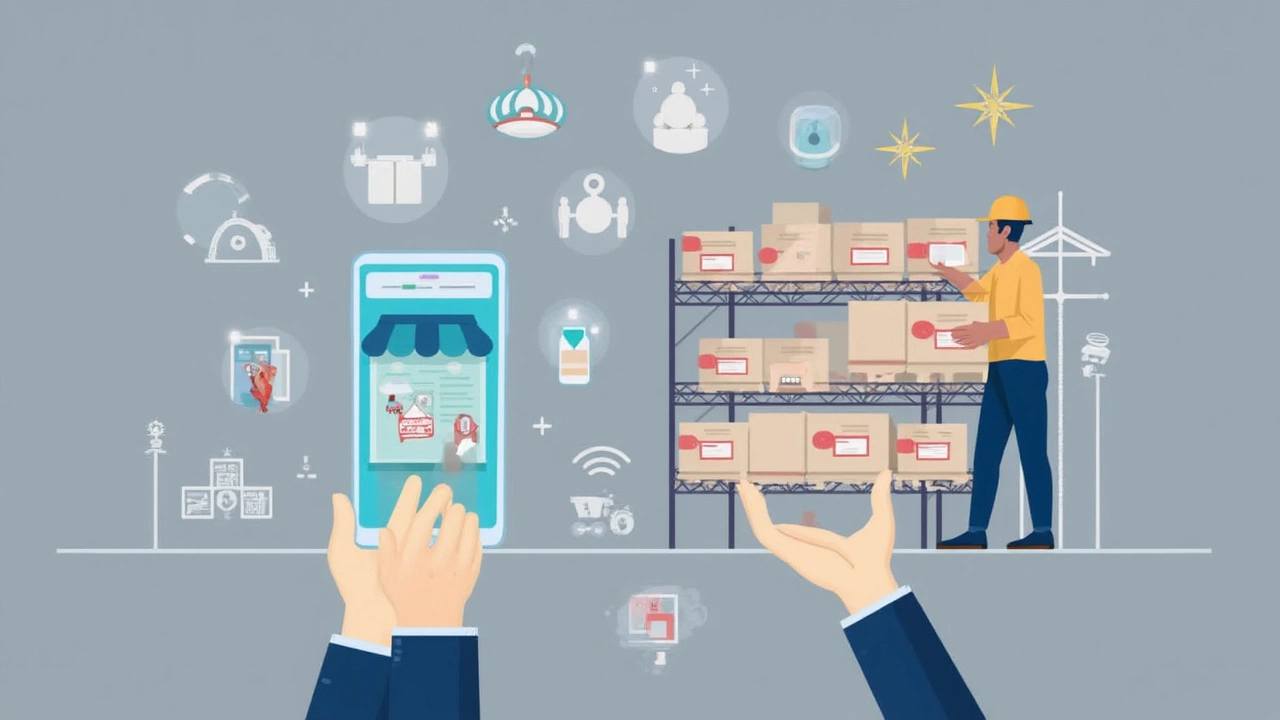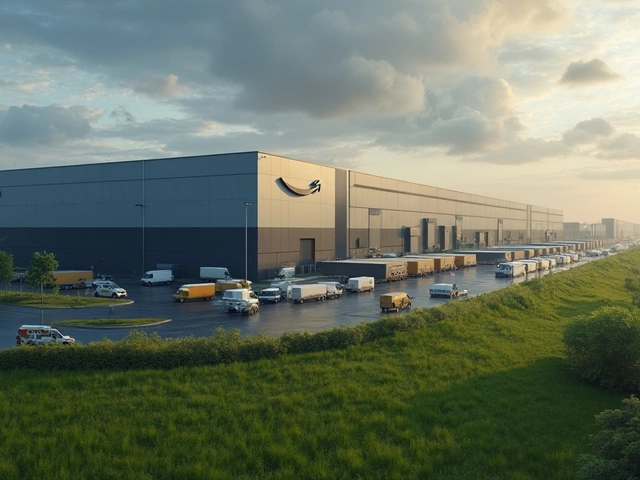Think all online shops work the same way? That’s a huge myth. There’s a big difference between running a classic e-commerce store and doing dropshipping. It all boils down to who actually stores and ships the stuff people buy from your site.
With a regular e-commerce store, you, as the shop owner, have to keep the products somewhere—maybe your garage or a rented warehouse. You manage the inventory, pack the orders, and arrange shipping. Your hands get dirty pretty fast.
Dropshipping flips the script. You put up products for sale, but you don’t touch a single item. When someone buys from your store, you pass their order to a supplier who ships it straight to the customer for you. No boxes, no packing tape, no delivery headaches on your end. But does that mean dropshipping and e-commerce are worlds apart? Or is it just a subtle difference?
- What Is Regular E-Commerce?
- How Dropshipping Works
- Who Handles the Logistics?
- Profit Margins and Risks
- Which One Is Easier to Start?
- Choosing What Works for You
What Is Regular E-Commerce?
Regular e-commerce is what most people picture when they think about selling online. Basically, you buy products up front—either from manufacturers, wholesalers, or even create your own stuff—then you list those products for sale on your site. When a customer places an order, you’re the one packing, labeling, and shipping it out. If you’ve ever ordered from a big online store like Amazon or a smaller Shopify store, that’s regular e-commerce in action.
This model gives you total control. You decide on product quality, how it’s packed, and how fast shipping goes out the door. But it also means you’re taking on more risk—money tied up in stock you might not sell and a pile of boxes in your living room if things slow down.
Standard e-commerce usually looks like this:
- You buy products and store them (at home, in a rented space, or a fulfillment center).
- Products are showcased in your online store.
- You personally handle every order—from picking and packing to shipping it out.
- Customer service and returns? That’s on you, too.
Handling logistics can get tricky and sometimes expensive, especially as you scale up. Rent, packaging, and even labor costs start to add up if you get a ton of orders. Studies show that shipping and fulfillment can eat up about 15%-20% of your overall costs if you’re not careful, and inventory mistakes (from overstocking or stockouts) cost U.S. retailers roughly $1.1 trillion per year. Here’s a snapshot:
| Aspect | Typical E-Commerce |
|---|---|
| Inventory | You buy and store it |
| Order Fulfillment | You pack & ship |
| Risk | Leftover stock, upfront money |
| Control | Full—quality, experience, delivery |
Biggest draw? You call the shots. Biggest headache? Juggling products, storage, and shipping. Want more hands-on control over your business and customer experience? e-commerce is the way to go, but get ready to hustle.
How Dropshipping Works
Dropshipping is kind of like having your own online shop without ever having to touch the products you sell. Here’s the breakdown: you list items for sale on your store, but the products actually sit with a third-party supplier—often somewhere far away, maybe even overseas. When someone places an order, you buy that product from your supplier, who ships it straight to your customer. You never see the product yourself.
One cool fact: Shopify reported in 2024 that over 23% of all online shops now use dropshipping as their main e-commerce method. Why? It’s because you skip a bunch of hoops like warehousing and dealing with bulk shipments.
"Dropshipping removes the need for inventory management but requires sharp focus on supplier relationships," says Oberlo, a major e-commerce platform.
Here’s how the typical dropshipping process works in four simple steps:
- You pick products from a supplier and publish them on your online store.
- A customer finds something they like and places an order on your site.
- You purchase the item from your supplier, paying their wholesale price.
- The supplier packs and ships the item directly to your customer—using your store’s name and brand.
Pretty hands-off, right? But there are some things to watch for. Delivery can take longer, especially if your supplier is based overseas. And you’re trusting someone else with customer satisfaction, since you can’t inspect each item yourself.
Take a look at some quick numbers on common dropshipping suppliers and average shipping times:
| Supplier Name | Typical Region | Average Shipping Time |
|---|---|---|
| AliExpress | China | 2-4 weeks |
| Spocket | US/EU | 2-7 days |
| Modalyst | US/EU | 3-8 days |
The freedom with dropshipping is huge, especially if you want to run a business without a big budget. But it comes with trade-offs you can’t ignore, especially when it comes to customer service and control. If you’re serious about trying e-commerce, knowing how dropshipping really works will save you headaches later.
Who Handles the Logistics?
This is where things really split between traditional e-commerce and dropshipping. That word, "logistics," just means figuring out how to store, pack, and ship stuff to your customers. Who takes care of all this work can make or break your business.
In classic e-commerce, you are responsible for nearly everything after someone clicks that buy button. You stock up, keep track of inventory, pack each order yourself, and deal with returns. If shipping delays hit, your inbox fills up fast with questions and angry messages.
Dropshipping is totally different. You don't touch a single product. Here's how it usually goes:
- Your store sells an item.
- You pay the dropshipping supplier for that item.
- The supplier picks, packs, and ships the order directly to the customer.
So, all the behind-the-scenes stuff—shipping, boxing, tracking—is someone else's job. This can save you hours (and a lot of stress). The tradeoff? You lose control over shipping speed, packaging, and sometimes even inventory accuracy.
Here’s how they stack up side by side:
| Logistics Task | Traditional E-Commerce | Dropshipping |
|---|---|---|
| Order Packing | Done by you or your team | Handled by supplier |
| Inventory Storage | Your warehouse or storage space | Supplier’s warehouse |
| Shipping Orders | Arranged and paid by you | Arranged and paid by supplier |
| Returns Management | You process returns | Supplier’s rules apply |
| Inventory Updates | Your responsibility | Supplier’s responsibility |
Think about this: Over 80% of shoppers say fast shipping makes them more likely to buy again. If your supplier ships slow, that’s your store’s reputation on the line, even in dropshipping. So, always check supplier reviews and run a test order on yourself before selling anything online.

Profit Margins and Risks
If you’re torn between e-commerce and dropshipping, it’s impossible to ignore the money talk. Spoiler: margins look really different in each model, even though both can bring in a steady income when done right.
With a traditional e-commerce store, you buy products in bulk, usually at a lower per-unit cost. You can set your own retail prices, giving you more control over profit margins. Plenty of people shoot for 30-50% markup, and sometimes more for specialty items. But here’s the catch: you pay upfront for inventory and take on the risk if things don’t sell. Unsold stock collects dust—and drains your cash.
Dropshipping looks tempting since you don’t shell out money for stock. You only pay the supplier after a customer pays you. That’s way less risky in terms of leftover inventory, but there’s a trade-off. Your cost per item is higher, and suppliers set those prices. Most dropshipping margins land between 10-25%. It’s lower, but the up-front risk nearly disappears.
| Model | Average Profit Margin | Upfront Investment | Inventory Risk |
|---|---|---|---|
| Classic E-Commerce | 30-50% | $500-$5,000 (for initial stock) | High (unsold goods) |
| Dropshipping | 10-25% | Low to $0 | Very Low |
Chargebacks, shipping mix-ups, and supplier errors can eat into profits no matter which model you pick. In dropshipping, you also have less control over product quality since you never see the goods before they reach your customer. That can lead to unhappy buyers and refund requests that chip away at your bottom line.
Want a quick tip? If you go dropshipping, pick reliable suppliers and communicate shipping times clearly on your product pages. For classic e-commerce, don’t over-order. Start with smaller batches and scale only when you know what actually sells.
Which One Is Easier to Start?
If you’re itching to launch an online shop but don’t want to jump through a bunch of hoops, dropshipping is usually the easiest way in. You don’t need to buy stock up front, which takes a lot of risk (and money) off your shoulders. There’s no need to rent storage space or build an order-packing station in your living room.
Setting up a e-commerce store the traditional way means you’ve got to put down cash up front to buy inventory. That can get pricey, especially if you’re selling electronics or higher-end gear. You’ll also need a spot to keep your products, which could mean paying for warehousing. Plus, you’re on the hook for things like packaging supplies and maybe even label printers.
The actual process of starting is different for both models:
- Dropshipping: Pick your products, connect your store to a supplier (using plugins on Shopify or WooCommerce makes this super simple), and list the items on your site. Once you’ve done that, you’re pretty much ready to sell. No worrying about boxes crowding your hallway.
- Traditional E-commerce: Find suppliers, order stock (sometimes in bulk), wait for it to arrive, handle storage, and get everything set up for shipping. Plus, you’ll deal with returns and tracking inventory.
Lots of would-be shop owners go straight to dropshipping because you can launch in a weekend and usually with under $200. Most of that is for a decent website, a domain name, and maybe a few basic marketing tools. In comparison, starting a traditional e-commerce business can cost thousands before you’ve sold anything. That can be a dealbreaker if you just want to test out a business idea without risking your savings.
But here’s a tip: easier to start doesn’t mean easier to succeed. Since dropshipping is so accessible, competition is fierce. Your store still needs standout products, sharp branding, and good customer support to really make it.
Choosing What Works for You
So, should you launch your own full-blown e-commerce store or dip your toes into dropshipping? Picking the right path depends on your budget, time, and how much control you're after.
If you're fine with investing upfront, handling stock, and don't mind getting involved in packing and returns, a regular e-commerce store gives you more power over your brand. You can even offer custom packaging and fast shipping. But these perks come with extra costs and more time spent managing inventory. For example, U.S. warehouse space averages around $8 per square foot per year, and shipping supplies can eat up 2-4% of your product costs.
Dropshipping is lighter on risk and startup cash. You don't buy products until your customer pays you, which is why roughly 27% of online retailers use this model for at least some products. However, profit margins are usually lower—think 10-20% compared to 30-40% in traditional e-commerce. You're also at the mercy of suppliers, so if they mess up an order, your customer blames you.
| Model | Inventory Needed? | Startup Costs | Control Over Branding | Average Profit Margin |
|---|---|---|---|---|
| E-commerce | Yes | $2,000 - $10,000+ | High | 30-40% |
| Dropshipping | No | $100 - $1,000 | Low | 10-20% |
Still not sure? Ask yourself these questions:
- Do I want to spend time and money on storage, or do I want something turnkey and easy to run?
- Is having unique branding and fast delivery vital for my customers?
- Am I okay with lower profits for less risk, or do I want maximum earnings even if it means more work?
If you want to start small with little risk, dropshipping is easier and cheaper, but you lose some control and earning potential. If brand experience and bigger profits matter, and you're ready to hustle, classic e-commerce might fit better. Tons of store owners even mix both—using dropshipping to test new products before investing in stock. The best model is the one that matches what you're willing to invest—and what you want out of your business.





